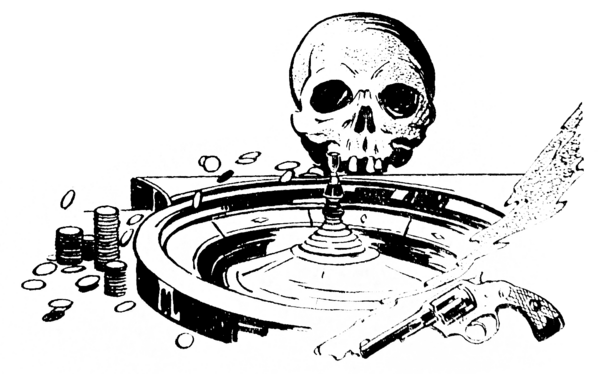Weird Tales/Volume 36/Issue 1/Superstitions and Taboos


As the traditional companion of witches, the black cat has become an omen that misfortune and ill luck will quickly follow in its wake… In early times superstitious people believed that witches and evil spirits could assume the forms of black animals, particularly black cats—and during the middle ages the brain of a black cat was considered an important ingredient in witchcraft recipes and prescriptions! The old notion concerning the nine lives of a cat goes back to the Ancient Egyptians whose cat-headed goddess, Pasht, was believed to have nine lives… They regarded black cats with the utmost reverence and mummified remains of them are frequently found in the same tombs as their worshippers!
 |
 |
 |
The origin of the very old superstition that a four-leafed clover' portends fortune and happiness is lost in antiquity… One old legend is that Eve, upon being ejected from the Paradise, took a four-leafed clover with her.
Because the clover was a bit of green from the Garden of Paradise, its presence in one's own garden came to be looked upon as an omen of good luck… At one time there was a custom of strewing four-leafed clovers as good luck omens before a bride to insure her happiness.

In Monte Carlo and other gambling places there is a belief that after a suicide of an unlucky player, all those playing against the bank will win! When the news of a suicide becomes known, therefore, the card rooms at once fill with eager players!

![]()
This work is in the public domain in the United States because it was legally published within the United States (or the United Nations Headquarters in New York subject to Section 7 of the United States Headquarters Agreement) before 1964, and copyright was not renewed.
- For Class A renewals records (books only) published between 1923 and 1963, check the Stanford University Copyright Renewal Database.
- For other renewal records of publications between 1922–1950 see the University of Pennsylvania copyright records scans.
- For all records since 1978, search the U.S. Copyright Office records.
- See also the Rutgers copyright renewal records for further information.
Works published in 1941 would have had to renew their copyright in either 1968 or 1969, i.e. at least 27 years after they were first published/registered but not later than 31 December in the 28th year. As this work's copyright was not renewed, it entered the public domain on 1 January 1970.
The longest-living author of this work died in 1956, so this work is in the public domain in countries and areas where the copyright term is the author's life plus 67 years or less. This work may be in the public domain in countries and areas with longer native copyright terms that apply the rule of the shorter term to foreign works.
It is imperative that contributors search the renewal databases and ascertain that there is no evidence of a copyright renewal before using this license. Failure to do so will result in the deletion of the work as a copyright violation.
![]()
Public domainPublic domainfalsefalse